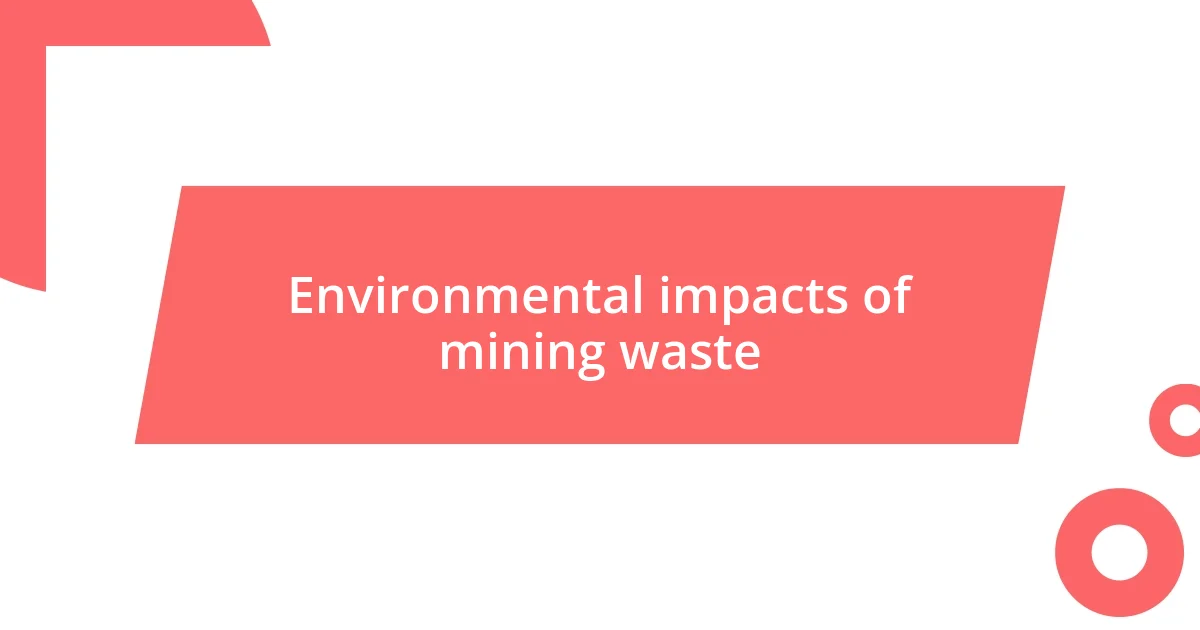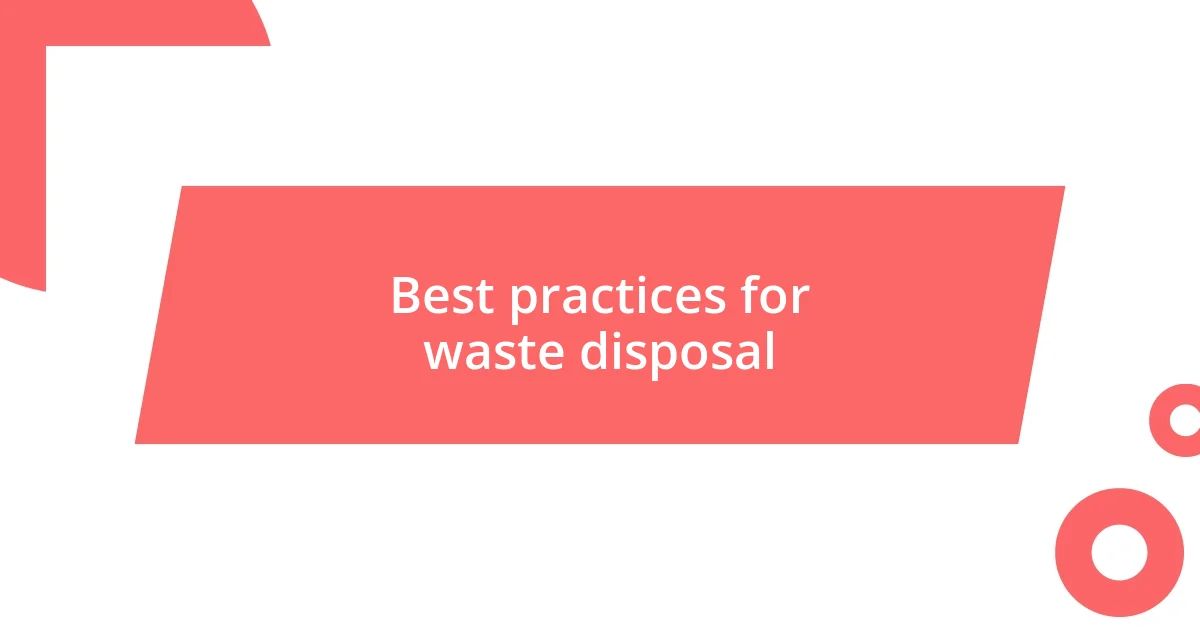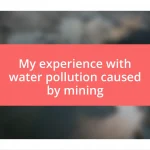Key takeaways:
- Mining waste management is essential for minimizing environmental impacts and includes innovative techniques like recycling and bioremediation.
- The main types of mining waste (tailings, overburden, waste rock, acid mine drainage, heap leach waste) present unique challenges and significant risks to ecosystems and communities.
- Effective regulatory frameworks and collaboration with local communities are crucial for ensuring compliance and fostering sustainable mining practices.

Understanding mining waste management
Mining waste management refers to the process of handling and disposing of the byproducts generated from mining activities. It encompasses the strategies and technologies employed to reduce the environmental impact of these wastes. Personally, I’ve seen firsthand how improper management can lead to devastating consequences for local ecosystems and communities—it’s heart-wrenching to witness the aftermath.
The sheer volume of mining waste is staggering, often exceeding the value of the ores extracted. I remember visiting a site where tailings, which are leftover materials after ore processing, formed massive dams. This immediate visual impact made me ponder: how can we live with ourselves knowing that if these structures fail, entire communities could be at risk? These are the questions that drive meaningful discussions about sustainable practices in the industry.
Effective waste management not only mitigates risks but also offers opportunities for resource recovery. I’ve encountered innovative solutions, such as recycling techniques that transform waste into valuable materials. It’s refreshing to see how some companies are embracing this approach, showing that with creativity and responsibility, mining can indeed tread a lighter footprint on our planet.

Types of mining waste
Mining produces various types of waste, each presenting unique management challenges. I recall a project in which I observed the massive heaps of overburden—unwanted rock and soil removed to access mineral deposits. These mountain-like formations can destabilize local landscapes and ecosystems, leading to soil erosion and biodiversity loss. It’s a stark reminder of how even the initial steps in mining have profound long-term effects.
Here are the main types of mining waste:
- Tailings: Fine materials left after ore processing, often stored in tailings ponds.
- Overburden: The soil and rock that must be removed to access ore deposits, contributing to landscape disruption.
- Waste Rock: Large pieces of rock that aren’t valuable and are typically discarded during the mining process.
- Acid Mine Drainage: Acidic water that seeps from abandoned mine sites, contaminating nearby water sources.
- Heap Leach Waste: Residual materials from a leaching process used to extract metals, which can leak toxic substances if not managed properly.
Witnessing these forms of waste firsthand has driven home the importance of responsible mining. The sight of tailings ponds can be overwhelming, reflecting not just the environmental footprint but also the potential risks if not managed effectively.

Environmental impacts of mining waste
The environmental impacts of mining waste are profound and far-reaching. I remember standing near a tailings pond and feeling an unsettling mix of awe and dread. The sheer scale of such a structure can be overwhelming, yet its presence signifies a potential disaster waiting to happen. These ponds, often laden with heavy metals and toxins, can leach harmful substances into nearby water sources, posing serious health risks to local communities and wildlife. It’s difficult to reconcile the need for resources with the damage we inflict on our environment.
Moreover, the cumulative effects of mining waste extend beyond immediate pollution. I witnessed the aftermath of a mining operation that left behind barren landscapes stripped of vegetation. The habitat destruction not only endangers local flora and fauna but also disrupts the delicate balance of the surrounding ecosystem. When I think about how these areas could have been vibrant ecosystems teeming with life, it stirs a deep concern for our environmental stewardship. It drives home the necessity for stringent regulations and responsible practices that can mitigate such lasting impacts.
What often gets overlooked is the long-term legacy of mining waste. I recall a conversation with a local resident who expressed frustration over how abandoned mines turned into toxic wastelands, affecting the livelihoods of generations. Communities often bear the brunt of this negligence, facing health hazards and economic challenges long after mining operations cease. It’s a stark reminder that our actions today will resonate for years to come, pressing the need for a more sustainable and responsible approach to mining waste management.
| Type of Mining Waste | Environmental Impact |
|---|---|
| Tailings | Can leak heavy metals into water sources, harming aquatic life. |
| Overburden | Destroys natural landscapes and disrupts ecosystems. |
| Waste Rock | Can lead to soil erosion and loss of biodiversity. |
| Acid Mine Drainage | Introduces toxic substances into waterways, posing health risks. |
| Heap Leach Waste | Can leak harmful chemicals if not managed properly, contaminating soil and water. |

Best practices for waste disposal
Effective waste disposal in mining is crucial to minimizing environmental harm. One best practice I’ve seen in action is the use of engineered tailings storage facilities. I remember visiting a site that incorporated advanced monitoring systems, allowing for real-time assessment of potential leaks. It was remarkable how technology could safeguard ecosystems, making me feel more optimistic about the future of mining practices.
Another approach I advocate for is the implementation of waste recycling and reprocessing. During a field visit, I was fascinated by a project that focused on recovering valuable metals from waste rock, turning what was once a problem into a resource. This not only reduces the demand for virgin materials but also lessens the overall waste burden. It’s incredibly satisfying to think that waste can be transformed into something useful, isn’t it?
Collaboration with local communities also plays a vital role in sustainable waste management. I recall a meeting with community representatives where they shared their concerns and insights about mining waste. Their firsthand experiences provided invaluable guidance for developing more effective waste disposal strategies. It’s a powerful reminder that engaging with those affected by our actions can lead to better outcomes for both the environment and the people relying on it. What practices have you seen that foster this kind of collaboration?

Innovative technologies in waste management
Innovative technologies are paving the way for more effective waste management in the mining sector. I once attended a demonstration of a groundbreaking bioremediation technique that used microbes to break down toxic substances in mining waste. Seeing those little organisms do their job made me realize the incredible potential of natural solutions in tackling pollution. Isn’t it fascinating how nature can provide answers to some of our most pressing problems?
Another promising development is the use of drones in monitoring mining waste sites. I was struck by how a simple flying device could collect data from otherwise hard-to-reach areas. This capability allows for early detection of potential leaks or environmental impacts, providing invaluable information to operators. It’s almost like having a watchful guardian hovering above—technology working hand-in-hand with environmental protection.
Additionally, I’ve seen advances in smart waste sorting systems that can automatically categorize and separate different types of mining waste. I remember visiting a facility where large quantities of waste were processed efficiently, reducing human error and increasing recycling rates. Witnessing this made me optimistic about the future; after all, if we can harness innovation effectively, we stand a better chance of leaving a cleaner planet for future generations, don’t you think?

Regulatory frameworks and compliance
Regulatory frameworks in mining waste management form the backbone of responsible operations. I recall sitting in on a workshop where government officials discussed the importance of compliance with environmental regulations. It struck me how these frameworks not only protect ecosystems but also create a level playing field for companies to operate transparently. Isn’t it comforting to know that there’s a systematic approach to ensuring mining practices don’t unduly harm our environment?
The challenge, however, lies in how these regulations are enforced and monitored. During my career, I’ve seen instances where compliance checks were rigorous, revealing significant insights into operational shortcomings. In contrast, I’ve also encountered cases where companies skirted regulations, leading to detrimental consequences for local ecosystems. This disparity made me wonder: how can we strengthen the enforcement of these regulations to ensure a more sustainable future in mining?
In my experience, collaboration between regulatory bodies and mining companies often leads to more effective compliance strategies. I’ve participated in discussions where industry leaders shared their experiences with new regulations and how that shaped their operations. It was refreshing to see companies proactively engage with the regulatory process, demonstrating that compliance isn’t just a checkbox; it’s an integral part of responsible mining. How often do we remember that successful partnerships can foster both economic and environmental benefits?















